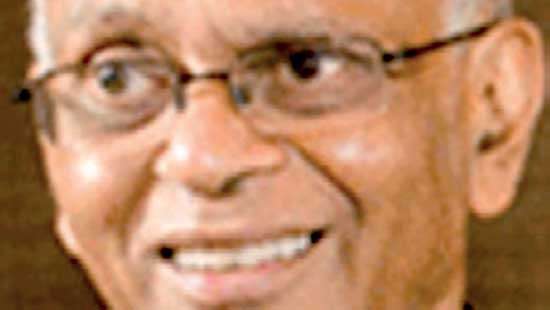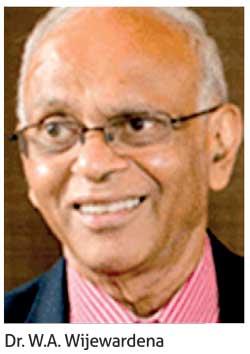Reply To:
Name - Reply Comment

Taking a swipe at Prime Minister Ranil Wickremesinghe’s repeated comments to the effect of the government having to rely on printed money to pay for essential government bills such as payment of salaries and pensions in the ensuing months, the former Central Bank Deputy Governor, Dr. W.A. Wijewardena likened it to giving sugar to a diabetes patient, to reflect the severity of the move in aggravating the current problems in the economy.
 In a shock move, the Central Bank in April raised its key policy rates by 700 basis points, the most in its entire history, to arrest inflation by killing demand and thereby reducing imports, which is putting pressure on the balance of payments.
In a shock move, the Central Bank in April raised its key policy rates by 700 basis points, the most in its entire history, to arrest inflation by killing demand and thereby reducing imports, which is putting pressure on the balance of payments.
The move was intended at throwing a wrench on private borrowings so that people’s savings that can be drawn into banks could be used to bridge the budget gap without resorting to the Central Bank printing money, which was partly responsible for the current bout of red hot inflation.
But the Premier’s recent statement to the effect of the government having to print at least another trillion rupees of money could scuttle the efforts thus far taken by the Central Bank to stabilise the economy, Dr. Wijewardena said.
“It is like giving a high dose of sugar to a diabetic patient,” he said at a virtual discussion organised by the Central Bank last week comprised of ex-Central Bankers deliberating on the way out of the crisis at present.
He also pointed out that it would be affront to the Central Bank’s independence entrusted and protected in the Monetary Law Act.
The Central Bank has bought nearly Rs.2.0 trillion worth government securities in the two years of the pandemic to provide support to the pandemic-hit economy and also to make up for the loss of revenues from the massive tax cuts enacted in late 2019.
However, the government last week restored the pre-2020 era tax policy with the hope of raking in Rs.125 billion in the remainder of the year and Rs.292 billion in 2023.
This was one fourth of what the experts claimed to have lost by the government due to the 2019 tax cuts in a year as they repeatedly said the State coffers lost Rs.600 billion in tax revenues each in 2020 and 2021.
The weaker estimates even at the pre-2020 tax framework reflect that a wobbling economy cannot generate tax revenues at whatever the rates.
And this was precisely why only a handful of economic analysts repeatedly called the government to abandon self-destructive lockdowns in 2020 and 2021, which killed thousands of jobs, livelihoods and small businesses, which otherwise could have brought in the revenues even at lower rates.
Dr. Wijewardena, although welcoming the tax reforms, which is expected to rekindle some confidence in the private sector, echoed that the revenue estimated from the reforms aren’t sufficient.
In an earlier press conference, the Central Bank Governor Dr. Nandalal Weerasinghe said they would have to assist the Treasury at times of exigencies and in instances such as payment of salaries and pensions of the State service, as not doing so could bring about worst outcomes as people would take to the streets in droves.
However, Dr. Weerasinghe in the same vein said that they now engage in money printing with utmost restraint unlike in the past.
Central banks and governments around the world loosened their purse strings to provide the largest ever stimulus on record in the two years of the pandemic at a time when the virus-related lockdowns forced factories to close and people to hunker down at homes, taking a massive toll on the productive capacity of the world.
And now the central banks are withdrawing their support as they are battling their worst ever inflation in four decades, but their tools remain limited to contain the supply side crunch caused by the pandemic induced-lockdowns, China’s zero COVID policy and Russia’s invasion of Ukraine.